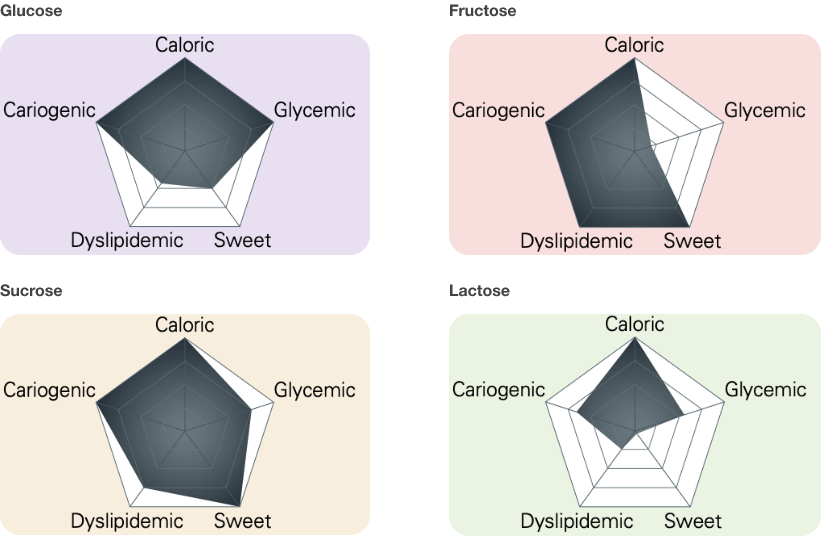A public health concern?
- The World Health Organization (WHO) reported that each year, cardiovascular and respiratory diseases, cancers, and diabetes cause 71% of deaths worldwide. A poor diet, obesity and lack of physical activity are some of the most common causes for these noncommunicable diseases (NCDs)1.
- Poor diet quality, rapidly increasing obesity rates, and the risk of NCDs are associated with high free sugars intakes2.
- Therefore, in order to reduce the risk of NCDs in children and adults, the WHO is encouraging actions to lower free sugars intakes2

What is sugar?
Sugars is a term referring to all mono- and disaccharides in foods, while sugar refers only to sucrose3. The main types of sugars and their food sources are:
Table 1. Types of sugars and their common sources
| Types of sugars | Common food sources | |
|---|---|---|
| Monosaccharide |
Fructose
|
Fruits, honey, high fructose corn syrup, some vegetables Cereals, breads, pasta, starchy vegetables, corn and other syrups A component of lactose, found in milk and dairy products |
| Disaccharide |
Lactose:
|
Milk and dairy products such as cheese, yogurt, ice cream and cream Table sugar from sugar cane or sugar beets Malted beverages, bread, molasses, beer |
What is the difference between total, free and added sugars?

Figure 1. Total, free and naturally occurring sugars definition
What are the main food sources of sugars?
- Milk and dairy products are the only source of lactose in the diet; they also provide beneficial nutrients, such as proteins, vitamins and minerals, especially calcium5.
- Fruits contain naturally occurring sugars (mainly fructose, glucose, and to a lesser extent sucrose) along with fibers, minerals and vitamins6. Compared to whole raw fruits, many of these beneficial nutrients are lost in fruit juices during processing. Whole fruits should therefore be favored over fruit juices.
- Sweetened baked goods and sugar-sweetened beverages are the common sources of added sugars (mainly sucrose, fructose, and glucose)7.

What role do sugars play?
- Sugars, and more generally carbohydrates, are a natural source of energy in our foods and a major source of fuel for the body8.
- Taste is the most obvious quality that sugars bring to food and beverages, but it is not the only one.
- Beyond sweetness, sugars also contribute to some important functional qualities of food, such as food preservation, volume of baked goods and browning9.

What are the recommendations for sugars intakes?
International organizations have not reached a common consensus on recommendations for dietary sugars intakes, due to insufficient scientific evidence.
- World Health Organization (WHO) strongly recommends limiting free sugars intakes to <10% of total energy requirements (strict recommendation). As a further recommendation (conditional recommendation), free sugars should be reduced to <5% of total energy requirements2.
- American Heart Association (AHA) recommends that added sugars consumption should not exceed 6% and 7% of daily energy requirements for women and men respectively10.
- Scientific Advisory Committee on Nutrition (SACN) recommends that average intakes of free sugars should not exceed 5% of total dietary energy for age groups from 2 years and older. The consumption of sugar-sweetened beverages should be minimized in both children and adults11.

How much is consumed globally?
- Across various geographical regions, intakes of added sugars are the highest in adolescents with mean values ranging from 12.4% to 18.6% of total daily energy intake12, therefore exceeding WHO’s recommendations of 10%.
- In the US, mean intakes of added sugars in adults correspond to 15% of daily energy intake13, while in the UK, they correspond to 12% of daily energy intake14.
- The major sources of added sugars in the diet across all age groups (>2 years) are sugar-sweetened beverages in US15 and Mexico16. In Europe, added sugars come from sweet foods (e.g. confectionery and pastries) followed by beverages14. Among 4 to 13-year-old Chinese children, added sugars are mainly provided by bakery products17.
- In the Philippines, the total sugars intake is within WHO’s recommendation of 10%. The mean usual intake of total sugar of 6-9 years old is 27.1 g/day (6.8%E) and of 19-49 years old adults is 26.3g/day (4.3%E)18, 19.

What are health impacts of excess sugars consumption?
Obesity, diabetes and cardiovascular diseases risk:
- High sugars consumption may lead to excess energy intakes, which are associated with increased body weight and risk of obesity. Such metabolic changes lead to alteration of glucose and fat metabolism, which are risk factors for many non-communicable diseases11.
- A high consumption of added sugars is also an indicator of poorer diet quality20, which may result in increased risk for metabolic disorders.
- Glucose and maltose are high glycemic sugars. A diet with a higher glycemic index (GI) is associated with a greater risk of type 2 diabetes5. Fructose and sucrose have a lower GI but may increase blood lipid levels21.
Dental caries:
- Higher consumption of sugars is associated with greater risk of dental caries11. Dental caries occur when orally fermentable carbohydrates from sugary foods and beverages interact with dental plaque bacteria5.
- Unlike other sugars, lactose (found in milk and dairy) has little impact on development of dental caries5.

What are the different characteristics of individual sugars?
Glucose, fructose, sucrose and lactose present the same caloric content. However, they have different expected impact on glycemic, lipidemia and dental caries, as well as varying sweetening power.

Figure 2. Characteristics of individual sugars
What are the regulations limiting sugars consumption?
Many governments around the world are developing or implementing some regulations to limit sugars consumption, including:
- Soda/sugar taxes: the French soda tax, Mexico’s sugary drinks tax, Philippines’ sugar-sweetened beverage tax22
- Labelling guidelines: warning labels in Chile, nutrition traffic light system in Ecuador22
- Advertising restrictions: ban on advertisement of foods high in fat, sugar and salt (HFSS) to children in UK23
- Education campaigns: the Norwegian School Fruit Programme, Hungarian Aqua Promoting Programme in the Young (HAPPY)24



 Nestlé
Nestlé














No comments here yet.